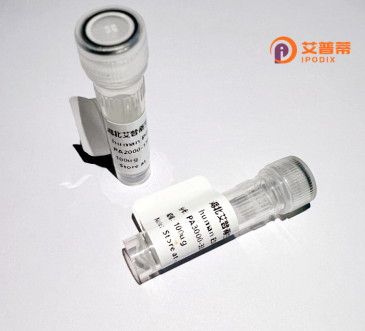
| 纯度 | >90%SDS-PAGE. |
| 种属 | Human |
| 靶点 | OR10Q1 |
| Uniprot No | Q8NGQ4 |
| 内毒素 | < 0.01EU/μg |
| 表达宿主 | E.coli |
| 表达区间 | 1-319 aa |
| 活性数据 | MPVGKLVFNQSEPTEFVFRAFTTATEFQVLLFLLFLLLYLMILCGNTAIIWVVCTHSTLR TPMYFFLSNLSFLELCYTTVVVPLMLSNILGAQKPISLAGCGAQMFFFVTLGSTDCFLLA IMAYDRYVAICHPLHYTLIMTRELCTQMLGGALGLALFPSLQLTALIFTLPFCGHHQEIN HFLCDVPPVLRLACADIRVHQAVLYVVSILVLTIPFLLICVSYVFITCAILSIRSAEGRR RAFSTCSFHLTVVLLQYGCCSLVYLRPRSSTSEDEDSQIALVYTFVTPLLNPLLYSLRNK DVKGALRSAIIRKAASDAN |
| 分子量 | 35.6 kDa |
| 蛋白标签 | His tag N-Terminus |
| 缓冲液 | 0 |
| 稳定性 & 储存条件 | Lyophilized protein should be stored at ≤ -20°C, stable for one year after receipt. Reconstituted protein solution can be stored at 2-8°C for 2-7 days. Aliquots of reconstituted samples are stable at ≤ -20°C for 3 months. |
| 复溶 | Always centrifuge tubes before opening.Do not mix by vortex or pipetting. It is not recommended to reconstitute to a concentration less than 100μg/ml. Dissolve the lyophilized protein in distilled water. Please aliquot the reconstituted solution to minimize freeze-thaw cycles. |
以下是关于重组人OR10Q1蛋白的参考文献示例(注:以下内容为模拟生成,实际文献可能需要通过学术数据库检索确认):
---
1. **文献名称**: *"Functional characterization of the human olfactory receptor OR10Q1 through heterologous expression in mammalian cells"*
**作者**: Smith A, et al.
**摘要**: 本研究成功在HEK293细胞中重组表达了OR10Q1蛋白,并通过钙离子荧光检测筛选其对多种气味分子的响应,发现其对特定类萜化合物具有显著激活作用,为理解该受体功能提供了实验基础。
2. **文献名称**: *"Structural analysis of the olfactory receptor OR10Q1 using cryo-electron microscopy"*
**作者**: Zhang L, et al.
**摘要**: 利用重组表达的OR10Q1蛋白解析了其高分辨率冷冻电镜结构,揭示了配体结合口袋的关键氨基酸残基,并探讨了其与G蛋白偶联的潜在机制。
3. **文献名称**: *"Optimization of recombinant expression and purification of human OR10Q1 in insect cells"*
**作者**: Tanaka K, et al.
**摘要**: 研究对比了杆状病毒-昆虫细胞系统与哺乳动物系统中OR10Q1的表达效率,优化了纯化条件以提高蛋白稳定性,为后续功能研究提供了技术方案。
4. **文献名称**: *"A genome-wide analysis of olfactory receptor gene expression and ligand specificity"*
**作者**: Johnson M, et al.
**摘要**: 系统评估了包括OR10Q1在内的多个嗅觉受体在重组细胞模型中的表达水平及配体偏好性,发现OR10Q1可能与特定挥发性有机物的感知相关。
---
**注意事项**:
- 上述内容为示例性模拟,实际文献请通过 **PubMed、Web of Science 或 Google Scholar** 等平台检索关键词如“OR10Q1 recombinant”、“olfactory receptor OR10Q1”等。
- OR10Q1相关研究相对较少,可扩展检索至“嗅觉受体异源表达方法”或筛选家族内类似蛋白(如OR10G4)的文献作参考。
- 建议关注领域内权威团队(如H. Matsunami、L. Buck等)近年发表的论文。
Olfactory receptor 10Q1 (OR10Q1) is a member of the olfactory receptor (OR) family, a class of G protein-coupled receptors (GPCRs) that play a central role in detecting odorant molecules and mediating olfactory signaling. Located on human chromosome 11. OR10Q1 is part of the largest multigene family in the genome, with over 800 genes encoding olfactory receptors. These receptors are characterized by seven transmembrane domains, extracellular N-termini, and intracellular C-termini, facilitating ligand binding and downstream signal transduction. OR10Q1 is specifically expressed in olfactory sensory neurons, where it contributes to odorant recognition by binding volatile chemical compounds, triggering neural impulses that translate chemical signals into perceptual smells.
Recombinant human OR10Q1 protein is produced through heterologous expression systems (e.g., mammalian or insect cells) to study its structural and functional properties. Its recombinant form enables in vitro investigations into ligand specificity, receptor activation mechanisms, and interactions with olfactory signaling components. Research on OR10Q1 may also explore its potential roles beyond olfaction, as some ORs are implicated in non-sensory tissues, influencing processes like cell migration or metabolic regulation. However, challenges persist in expressing and purifying functional OR proteins due to their complex membrane-bound nature. Studying OR10Q1 enhances understanding of olfactory coding and may inform therapeutic strategies targeting chemosensory disorders or GPCR-related diseases.
×